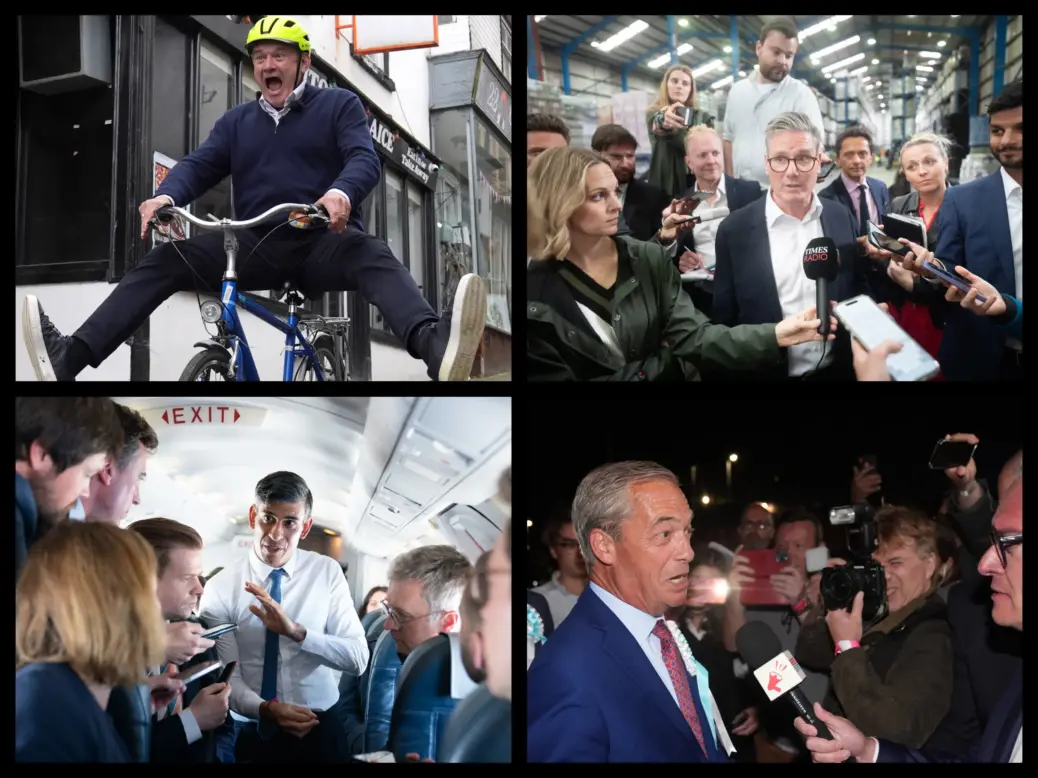
Page views to news and politics content across the UK’s leading publishers are believed to have reached a record high in the week of the general election vote.
News and politics page views recorded for publishers that are members of online advertising network Ozone totalled 193.8 million between 1-7 July, up 15% week-on-week.
Separated out, politics page views also reached what is believed to be a record of 93 million, up 56% week-on-week, in the week of polling day (Thursday 4 July).
News publishers represented by Ozone, which was created in 2018 as a collaboration between leading UK publishers, include: Reach, News UK, The Guardian, The Telegraph, Mail Metro Media, The Independent, Huffpost, Evening Standard, City AM, Pink News and DC Thomson.
Ozone claims to reach 38 million unique users per month with news and politics coverage.
It said its “total daily audience on the result day was 20% higher than the average of the previous seven days, highlighting the impact on total audience reach during these tentpole moments in UK history”.
Charted: Politics page views peak for election results
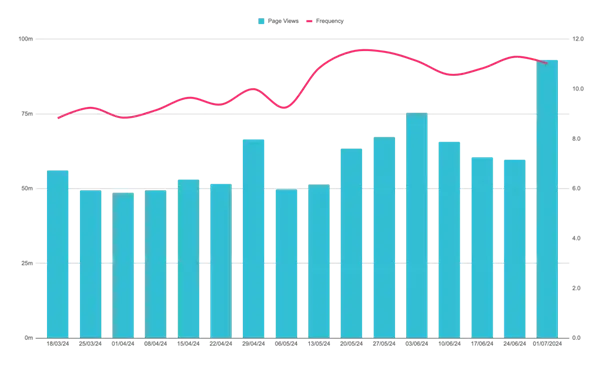
Before the elections, the top two weeks for politics page views according to Ozone were both in September 2022: the week that saw both Liz Truss become prime minister and the death of the Queen, and then the week of Queen’s funeral.
Press Gazette previously reported that the Queen’s death saw the biggest traffic surge to UK newsbrands since the 2020 US election according to Ipsos iris data.
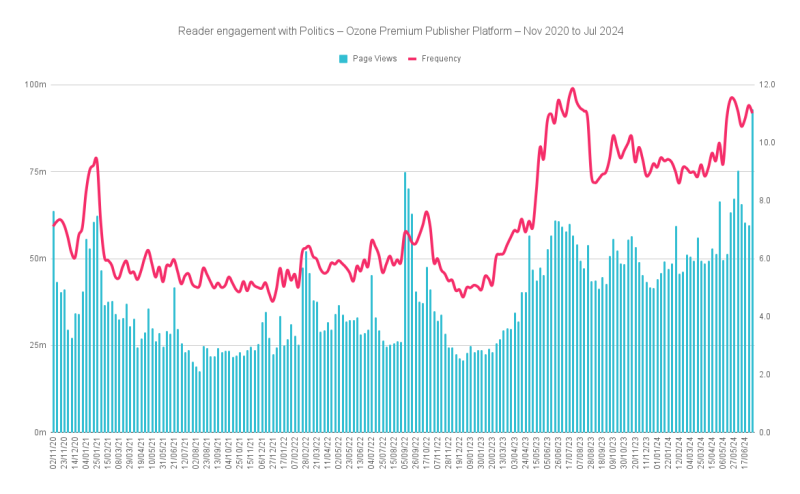
Aside from the week of polling day on 4 July, the next biggest week for politics page views during the election campaign was the week beginning 3 June which was when Reform UK leader Nigel Farage announced he would stand as an MP and also when Sunak left the D-Day 80th commemorations in France early to do an ITV News interview.
That week saw more than 75.3 million politics page views – at the time making it a record high since Ozone has been capturing data – which was up 12% week-on-week. It beat the week of Truss’s appointment as PM and the Queen’s death by 1%.
The same week also had the second highest overall news and politics page views for the campaign on 173.3 million, with 12% week-on-week growth also attributed in part to the story about the disappearance of TV doctor Michael Mosley in Greece and the subsequent discovery of his body.
Politics page views fell for each of the subsequent three weeks although the 60.4 million recorded in the week commencing 17 June was still 12% higher than the 2024 weekly average to date.
The first full week of campaigning, between 27 May and 2 June, had seen a 6% week-on-week rise in engagement with politics coverage with 67.3 million page views almost a third higher than the 2024 average to that point.
Similarly news and politics page views overall peaked first in the week commencing 3 June on 173.3 million before falling – although they did actually increase each week again until the results.
Ozone said it had 150 million page views to the big policy verticals throughout the campaign: healthcare saw 59.3 million page views, economy had 32.8 million, defence (led by Sunak’s national service pledge) was on 31.9 million, immigration was on 11.7 million and the environment saw 11.6 million.
In May, which also included the local elections at the start of the month as well as the general election being called and the start of campaigning, there were 263 million page views to politics content in total - 60% higher than the monthly average.
Generally, Ozone said at the start of the campaign, politics page views rise by 39% on average during major events.
It said: "During the past three years, in weeks when major events have dominated the political agenda – from elections and policy changes to resignations and new appointments – Politics page views are typically nearly two-fifths higher than the weekly average."
Starmer wins battle for share of voice among party leaders
The Ozone data also showed that across the six-week campaign Starmer received a 40% share of the voice among the party leaders before Labour won with a 34% share of the vote.
Although Sunak was more prominent in coverage before he called the election, the ex-PM was second place with a 35% share of the voice throughout the campaign, with a 24% eventual vote share.
Reform's Farage had a 19% share of the voice with a 14% vote share while Lib Dem leader Ed Davey, whose campaign was characterised by stunts such as bungee jumps and water slides, had a 5% share of the voice but a 12% vote share.

Farage's share of coverage jumped by 15 percentage points in the week he announced he would run as an MP and he even briefly overtook Sunak in the week commencing 17 June when he told the BBC the West had provoked the Russian invasion of Ukraine and received critical coverage including in the Mail on Sunday.
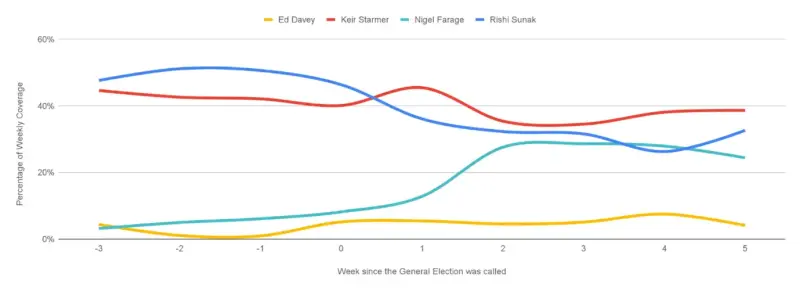
Media sentiment towards each of the main parties in the 2024 election campaign
Content sentiment analysis also shared by Ozone showed that three of the four biggest parties by vote share - Labour, Reform UK and Lib Dems - had a very similar level of positive coverage at the end of the campaign on 31%, 30% and 32% respectively.
The Conservatives were behind on 22% having failed to see a similar jump from 19% of coverage being positive at the start of the campaign compared to Labour (which also started on 19%) and the Lib Dems (which started on 17%).
Labour's negative coverage fell by the most from 47% to 38%.
Reform saw a fall in positive coverage from 44% to 30% over the six weeks although negative sentiment stayed steady at just over a third. However there were some blips in the middle: in the week beginning 3 June, when Farage announced his candidacy, Reform's negative coverage was on 59% while in the week of 24 June which saw a racism row for the party led by Channel 4 News reporting its negative sentiment rose to 61%, equal with the Conservatives, and its positive sentiment fell to 8%, below the Tories' 12%.
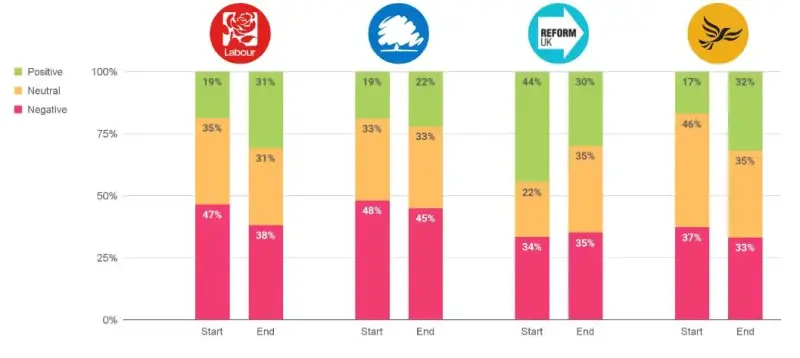
Email pged@pressgazette.co.uk to point out mistakes, provide story tips or send in a letter for publication on our "Letters Page" blog
